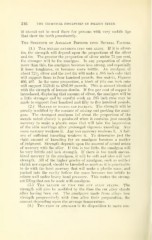Page 646 - My FlipBook
P. 646
316 THE TECHNICAL, PEOCEDUEES IN FILLING TEETH.
it should not be used there for persons with very mobile lips
that show the teeth prominently.
The Steength of Amalgam Depends upon Several Factors.
(1.) The metals entering into the alloy. If it is silver-
tin, the strength will depend upon the proportions of the silver
and tin. The greater the proportion of silver under 75 per cent,
the stronger will be the amalgam. In any proportion of silver
more than this, the amalgam becomes less strong, and especially
it loses toughness, or becomes more brittle. An amalgam of
about 721-2 silver and the rest tin will make a .085 inch cube that
will support three to four hundred pounds. See matrix, Figures
406, 407. In the same proportion, a block of this one inch cube
will support 3529.41 to 4705.88 pounds. This is almost identical
with the strength of human dentin. If five per cent of copper is
introduced, displacing that amount of silver, the amalgam will be
a little stronger and by careful work an .085 inch cube may be
made to support four hundred and fifty to five hundred pounds.
(2.) Manner of mixing and packing. The strength will be
greatly modified by the manner of mixing and packing the amal-
gam. The strongest amalgam (of about the proportion of the
metals noted above) is i5roduced when it contains just enough
mercury to make a plastic mass that will take the impression
of the skin markings after prolonged vigorous kneading. Any
more mercury weakens it. Any less mercury weakens it. A fail-
ure of sufficient kneading weakens it. To determine just the
right amount of kneading for an amalgam becomes a matter
of judgment. Strengih depends upon the amount of actual union
of mercury with the alloy. If this is too little, the amalgam will
be very brittle and lack strength. If there is too much uncom-
bined mercury in the amalgam, it will be soft and also will lack
strength. All of the higher grades of amalgam, such as neither
shrink nor expand, should be kneaded as much as it is practicable
to do with the least mercury that will make a plastic mass, and
packed into the cavity before the mass becomes too brittle to
cohere well under heavy hand pressure. This makes the strong-
est filling that can be made with amalgam.
(3.) The length of time the cut alloy stands. The
strength will also be modified by the time the cut alloy stands
after having been cut. The amalgams made from alloys lose
strength progressively with time after their preparation, the
amoimt depending upon the average temperature.
(4.) The flow of amalgam is its disposition to move con-


